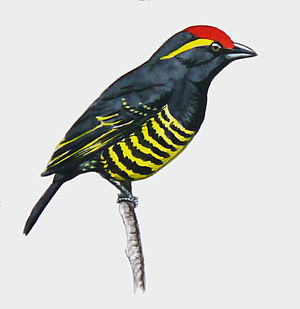Yellow-spot bearded bird
| Yellow-spot bearded bird | ||||||||||
|---|---|---|---|---|---|---|---|---|---|---|

Yellow-spotted bearded bird ( Buccanodon duchaillui ) |
||||||||||
| Systematics | ||||||||||
|
||||||||||
| Scientific name | ||||||||||
| Buccanodon duchaillui | ||||||||||
| ( Cassin , 1855) |
The yellow-spotted barbet ( Buccanodon duchaillui ) is a bird art from the family of African barbets . He is the only representative of the genus Buccanodon . The species occurs in Africa. No subspecies are distinguished. The IUCN classifies the yellow-spotted bearded bird as not endangered ( least concern ).
Appearance
Yellow-spot bearded birds weigh an average of 41 grams. The males have a wing length of 7.2 to 8.4 centimeters. The tail length is 3.5 to 5.0 centimeters. The beak reaches a length between 1.4 and 1.7 centimeters. Females have comparable body measurements. There is no sexual dimorphism .
Males and females have a red forehead, in some individuals also an orange-red forehead. There is a narrow black stripe between the forehead and the base of the beak. A yellow stripe runs from the end of the eye to the shoulders. The rest of the top of the head, the back of the head to the back, the ear covers, the throat and the middle of the chest are black. The back is black-blue with yellow spots. The control springs are black-brown to black on the upper side, and matt brown on the underside with a yellowish sheen. The spring shafts are matt yellow. The sides of the body as well as the lower chest, the belly and the under tail-coverts are striped yellow and black. The beak is black. The featherless skin around the eye is black, the eyes are dark brown. The legs and feet are gray to gray-brown. Young birds differ from adult birds by their dull plumage. They also lack the red plumage on their head.
There is no possibility of confusion, as the yellow-blotted bearded bird is the only small, forest-living species in its area of distribution with a black-yellow body plumage and a red forehead. Two African bearded birds resembling the yellow-spotted bearded bird, the diademed hair -bearded bearded and the fire-browed bearded bird , are not found in the range of the yellow-blotted bearded bird, have more white in their plumage and have no yellow spots or stripes on black plumage. However, the most noticeable distinguishing feature of the yellow-spotted bearded bird is its purring brrrrrr --- t , which lasts 1.2 to 2.1 seconds. This utterance can usually be heard repeatedly over a period of twenty minutes. The pause between the individual sequences is 90 to 120 seconds.
Distribution area and habitat
The range of the yellow-spotted bearded bird stretches from Sierra Leone, western Guinea and Liberia to the southwest of the Central African Republic , southern Uganda and western Kenya . In a southerly direction, the distribution area extends from there to Cameroon , Gabon and Zaire , western Rwanda and northwestern Tanzania . The yellow-spotted bearded bird is common regionally, but it is basically a hidden and inconspicuous species. In Cameroon it occurs at altitudes of 2150 meters and in Kenya of up to 2220 meters.
The habitat of the yellow-spotted bearded bird are forests with fruit-bearing trees. In addition to primary forests , older, well-developed secondary forests , overgrown forest clearings and plantations with tall trees are also settled.
Way of life
The yellow-spotted bearded bird often looks for food individually, usually in a tree region between eight and 30 meters above the ground. On very abundant fruit-bearing trees there is an occasional gathering of yellow-spot bearded birds. In this case, the two partners of a couple usually look for food in the same region of a tree and leave the tree at about the same time. However, they do not stay in close proximity while foraging for food. Fruits are eaten very quickly, with the beak usually being rubbed on a branch after swallowing a single fruit. Insects are also part of the food spectrum of the yellow-spotted bearded bird. Termites and small snails, among other things, are eaten. While foraging for food, the yellow-spotted bearded bird is occasionally driven away by larger African bearded birds such as the black bearded bird .
The breeding season in Liberia falls between August and June. In Ghana, yellow-spotted bearded birds breed mostly in February. Otherwise, very little is known about the reproductive biology of this species.
supporting documents
literature
- Lester L. Short, Jennifer FM Horne: Toucans, Barbets and Honeyguides - Ramphastidae, Capitonidae and Indicatoridae . Oxford University Press, Oxford 2001, ISBN 0-19-854666-1
Individual evidence
Web link
- Buccanodon duchaillui inthe IUCN 2013 Red List of Threatened Species . Listed by: BirdLife International, 2012. Retrieved February 2, 2014.